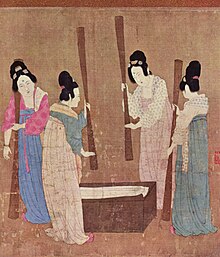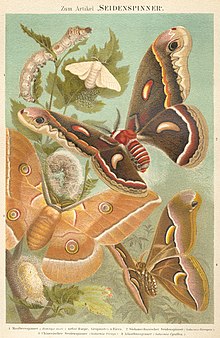Silk
Silk is a natural fibre made by the silk worm cocoon. Silk fibres are very strong and are often used to make cloth.


The cloth from silk can be made into rugs, bedding, or can be used to write or paint on. In the past, silk was used to make parachutes. The practice of growing silkworms for silk production is called sericulture.
Most spiders make a natural fibre of their own that is also called silk.
History
changeThe practice of breeding silkworms, known as sericulture, dates back to around 5000 BC during the time of the Yellow Emperor, Huang Di. Legend says that his wife, Lei Zu, introduced silkworm rearing and invented the loom, earning her the title Goddess of Silk.[1]
Chemical properties
changeSilk that is made by the silk worm is made up of two main proteins, sericin and fibroin.
Fibroin is the structural center of the silk and gives it its strength. It is made up of amino acids, which make the fibers strong and hard to break. The tensile strength is there because of hydrogen bonds. When silk is stretched, there is a strong force on these many bonds, so they do not break.
Serecin is the sticky material which surrounds the fibroin and gives it protection from the outside. Silk is resistant to most mineral acids, except for sulfuric acid, which dissolves it. Perspiration gives the silk a yellowish colour.
Related pages
changeReferences
change- ↑ "History of Silk | China Collection". china.lu. Retrieved 2024-10-02.